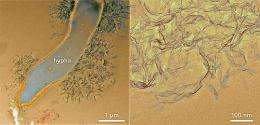Fungus study offers insights about biogeochemical cycling, bioremediation

Environmental Molecular Sciences Laboratory users helped fill a gap in the research community’s knowledge about the role of fungi and manganese (Mn) oxides in biogeochemical cycling and bioremediation.
Mn is a contaminant commonly found in coal mine drainage. Though high concentrations of soluble Mn, as the reduced Mn(II) ion, can be problematic, Mn oxides, whose formation is readily stimulated by bacteria and fungi, can be quite helpful.
These highly reactive compounds play a role in the cycling of nutrients and carbon in the soil and water, and importantly, they can serve as bioremediating agents by scavenging metals.
Previous Mn studies have centered on bacteria, but the role of fungi in Mn(II) oxidation and subsequent Mn oxide formation is just as important and was, therefore, the focus of EMSL collaborators from Harvard University—including EMSL Distinguished User Colleen Hansel— and the Stanford Synchrotron Radiation Light source (SSRL).
The research team fully characterized the Mn oxides produced by four different species of fungi isolated from coal mine drainage treatment systems in central Pennsylvania by integrating a broad suite of microscopy and spectroscopy tools, including high-resolution transmission electron microscopy (HR-TEM) equipped with energy-dispersive X-ray spectroscopy at EMSL and X-ray absorption spectroscopy at SSRL.
Their studies revealed that the species, growth conditions, and cellular structures of fungi influence the size, morphology, and structure—and, therefore, reactivity—of the Mn oxides. Their results underline the importance of species diversity in biogeochemical cycling and bioremediation.
More information: Santelli CM, SM Webb, AC Dohnalkova, and CM Hansel. 2011. “Diversity of Mn oxides produced by Mn(II)-oxidizing fungi.” Geochimica et Cosmochimica Acta 75(10): 2762-2776 DOI:10.1016/j.gca.2011.02.022
Provided by Environmental Molecular Sciences Laboratory


















